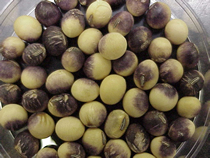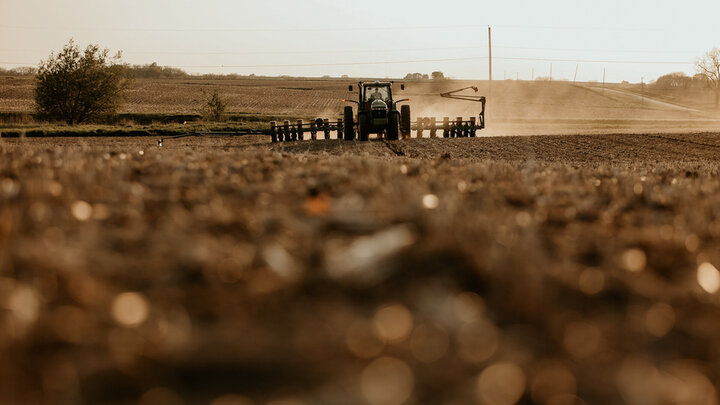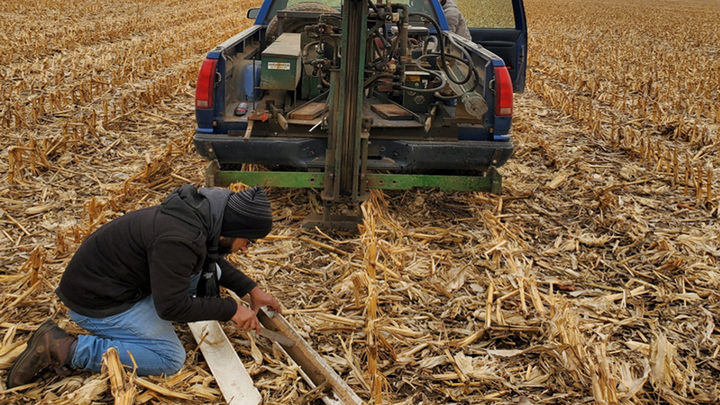By Loren J. Giesler, Former Extension Plant Pathologist
Pathogen
Purple Seed Stain (Cercospora blight) is caused by the fungus Cercospora kikuchii. It is also known by the names purple blotch, purple speck, purple spot or lavender spot. Purple seed stain infection of the seed does not directly reduce yield. However, if a high percentage of stained seed is harvested, grain dockage may occur or seed certification may be denied. Delayed germination may occur when seed discoloration exceeds 50% of the seed coat. The inoculum source for this disease is infected seed and debris from previous soybean crops.

Disease Symptoms
Symptoms of purple seed stain are usually expressed in the seed. Infected seeds may appear healthy or have pink to purple spots that range in size from specks to large blotches that cover the entire surface. The discoloration extends from the seed hilum in all cases. Yield is not affected by the seed phase of the disease but the value of crop is lessened when it is downgraded due to the color variation. Seeds with a very high percentage of discoloration have lower oil content and higher protein content compared to healthy seed. Germination and seedling emergence is lower from purple seed stain infected seeds than from those that are healthy. Germination affects are often a delayed germination or smaller seedling. Cotyledons of infected seedlings shrivel, turn purple and drop.
The leaf blight phase may be evident at the beginning of seed set. Young leaves on the upper portion of the plant are affected and have a dark reddish purple bronzing. Leaves will have irregular shaped reddish purple lesions that vary in size from small specks to spots that are ½ inch in diameter. Lesions occur on both upper and lower leaf surfaces. Large necrotic blotches form when the lesions coalesce and veinal necrosis may also be evident. Severely affected upper leaves are often shed with the petioles being held on the plant and the lower leaves remain attached. Infection sites on petioles and stems are sunken red lesions that can be up to ¼ inch in length.


Favorable Environmental Conditions
Purple seed stain fungi sporulation occurs under conditions of high humidity and temperatures of 73-80°F. Initial infections are often latent and do not appear visible until the R4 growth stage.
Sporulation studies have shown increases in spores with the amount of days with average air temperatures above 82 F.Seed infection in generally not limited by weather factors once initial infections have occurred.
Management
Genetic Resistance
Soybean varieties vary in their response to this fungus and it is thought that resistance to leaf and seed infections are under different genetic control
Cultural Practices
Crop rotation and residue incorporation will reduce inoculum by breaking down infested residue.
Chemical/Biological Control
Seed lots with a high percentage of infected seed should be treated with a seed treatment fungicide. Foliar fungicides may be applied during early pod stages R3-R5 to prevent blight and pod infections.
NebGuides
Seed Treatment Fungicides For Soybeans (G1852)
Foliar Fungicide Use In Soybean (G1862)
Soybean Diseases
- Soybean Diseases (Home)
- Anthracnose
- Bacterial Blight
- Bacterial Pustule
- Bean Pod Mottle Virus
- Brown Spot
- Brown Stem Rot
- Charcoal Rot
- Frogeye Leaf Spot
- Phytophthora Root and Stem Rot
- Pod and Stem Blight
- Purple Seed Stain
- Rhizoctonia Root Rot
- Sclerotinia Stem Rot
- Soybean Cyst Nematode (SCN)
- Soybean Mosaic Virus
- Soybean Rust
- Stem Canker
- Sudden Death Syndrome (SDS)








